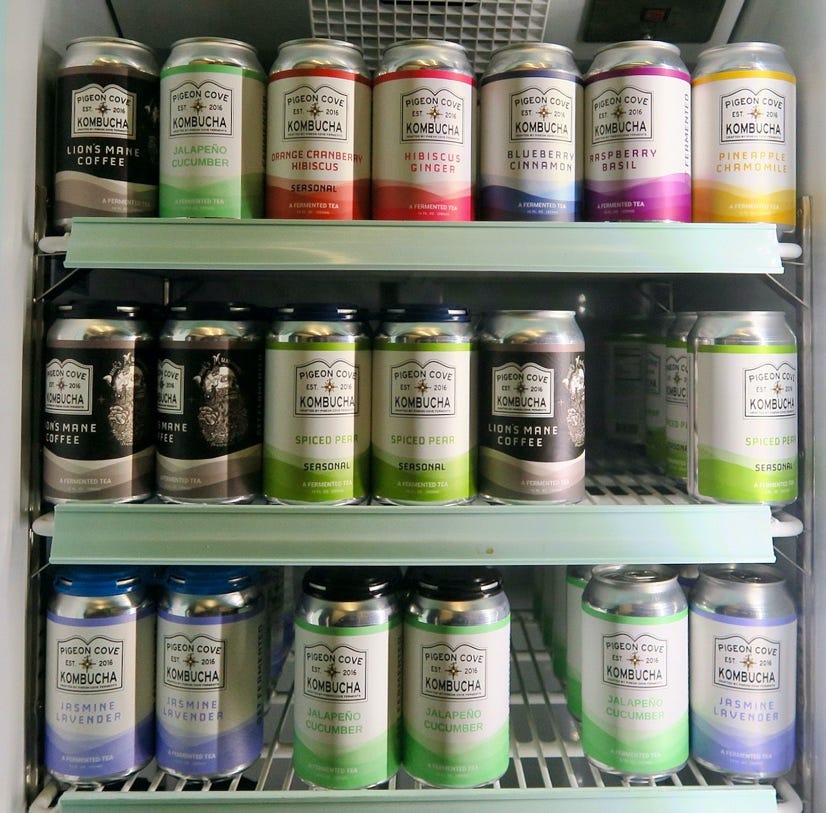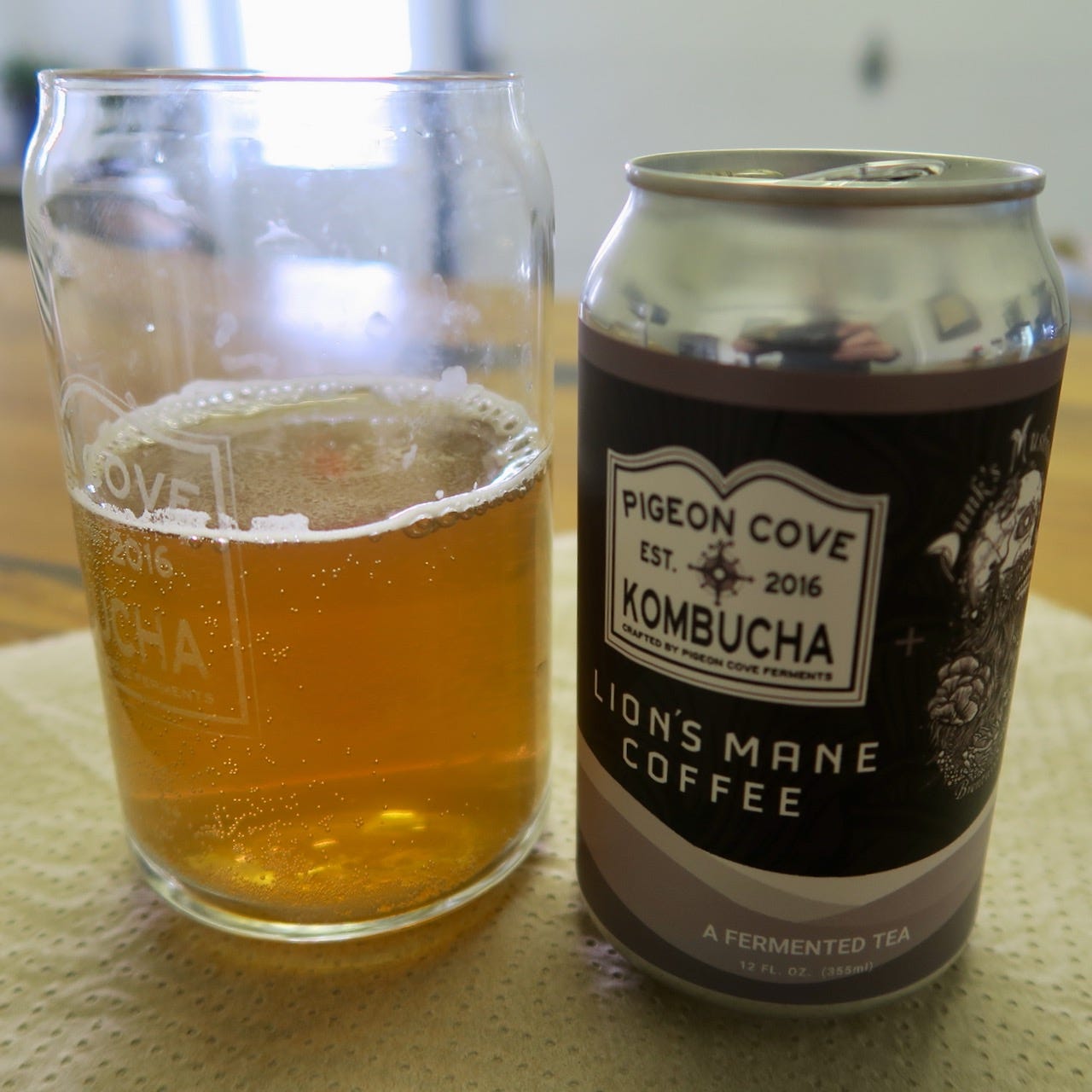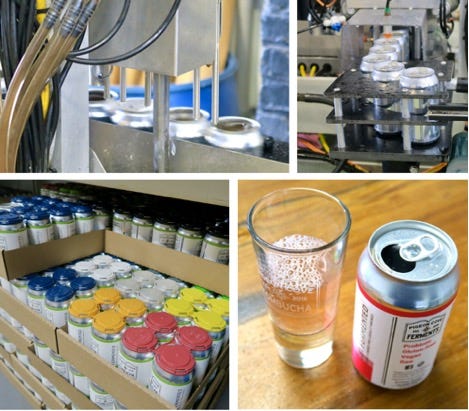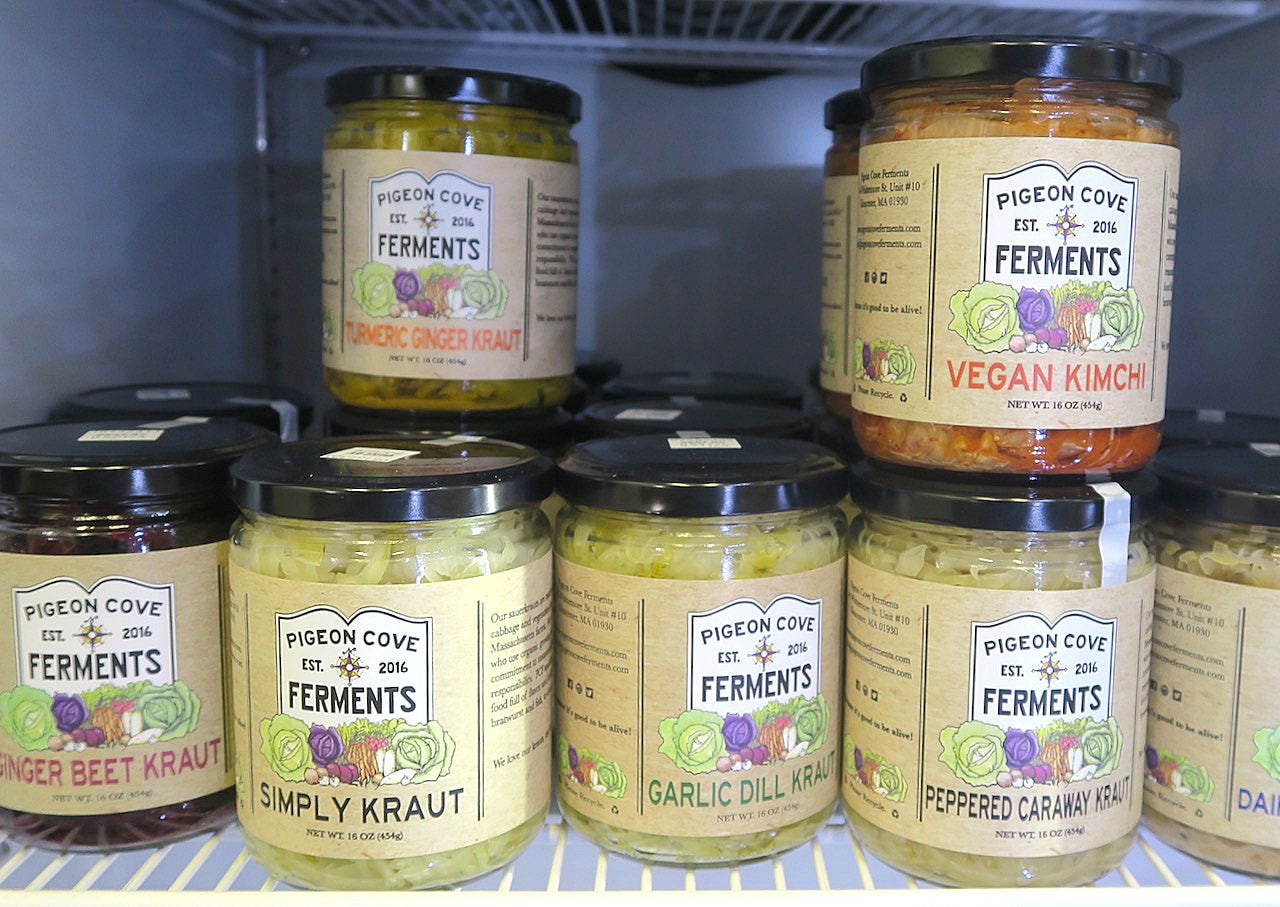I’ll start by clarifying a few points.
Point #1: Pigeon Cove Ferments is not in Pigeon Cove in Rockport, MA, anymore, but rather in Gloucester, MA, near the spot where the MBTA commuter rail crosses the Annisquam River.
Point #2: Not all kombucha tastes like what my husband unapologetically refers to as “baby vomit.”
Point #3 (most important): Pigeon Cove Ferments was founded and is operated by a highly motivated and creative husband and wife team: Dylan and Kristen L’Abbe-Lindquist.
During a recent visit to the Pigeon Cove Ferments’ taproom, said husband popped open a few cans of Pigeon Cove Ferments kombucha in the name of art. When he went to photograph the action shots you’ll see below, he noticed the kombucha didn’t have that sour smell he expected. Then he tasted it. Hmm. Not bad, he admitted.
For the record, I am an enthusiast of fermented foods and many types of kombucha, even the sour ones. Well before writing this piece, I’ve sampled and enjoyed the kimchi and sauerkrauts that Pigeon Cove Ferments makes and have started a one-woman campaign—right here, this is it—for them to make another batch of their fermented hot sauce.
I also like their kombuchas for the inventive flavor combinations such as raspberry basil, cucumber jalapeno, and ginger hibiscus. Plus, they create seasonal small batches of flavor combinations you won’t see anywhere else: purple pea flower and lime, kiwi green apple spirulina, elderberry ginger made with foraged elderberries, Meyer lemon and rosemary, and grapefruit cardamom, to name a few.
I visited Pigeon Cove Ferments on a grey January day to find out how the sausage sauerkraut is made, so to speak. The facility is located in an industrial area close to Gloucester’s Grant Circle and shares a building with neighbors such as Twin Light Smokehouse. If you visit the taproom, which is next to the factory floor, you can sample seasonal kombucha flavors, pick up four-packs of your favorites, fill a growler, and take in the art, which includes pieces by local artists including prolific Gloucester artist Jon Sarkin.
The facility was formerly the brewing space for Cape Ann Brewing, which is where Dylan worked for about 13 years, ultimately as head brewer. There are a few artifacts from the space’s former life as Cape Ann Brewing headquarters. The facility includes a production space that houses 1,000-gallon kombucha tanks and canning machinery—cute by major brewery standards, but effective. There is an adjacent room to store ingredients and finished product, rooms with ideal temperatures for fermenting sauerkraut and kimchi, a sizeable walk-in refrigerated space, and an airy upstairs office with a view of the MBTA commuter rail line and Annisquam River.
Dylan, you were the head brewer at Cape Ann Brewing Company. How does one become a head brewer? Did you start at the bottom and work your way up?
I had done some homebrewing and then apprenticed at Cape Ann Brewing in 2006. This was at the same time I was working two jobs and going to Salem State College. I continued working there part-time, and when I graduated with a degree in geology in 2008, I told the owner of Cape Ann Brewing [Jeremy Goldberg] that he could offer me a full-time job or I would have to get a geology job. He hired me and I took over brewing operations, which I did until December 2019 when it closed.
Were you making sauerkraut and kombucha before you started the business?
Yes, my wife Kristen and I made kombucha and sauerkraut. The smell of kombucha brewing reminds me of my childhood and my hippie parents. They made sauerkraut and grew a lot of food in their garden. I bought the house I grew up in from my mother about five years ago. We still have the garden.
And it’s in Pigeon Cove, hence the name?
Yes. Kristen and I started Pigeon Cove Ferments in 2016 with sauerkraut as our first product. We added kombucha in 2018, initially producing small batches, and it grew from there. Now kombucha is 80% of our business.
How were you selling your kombucha?
I started by dragging kegs to farmer's markets. [I have a fond flashback of drinking Pigeon Cove Ferments kombucha on draft and listening to the Headlands trio playing at the Rockport farmer’s market, circa 2019]. My original goal was to get our kombucha on draft into bars and restaurants to give people a nonalcoholic drink option. But then, COVID hit and all the restaurants and bars shut down.
Cape Ann Brewing had about 80,000 cans they didn’t need. My boss gave me the cans, and we bought a single can seamer [a machine that seals the lid after the can is filled]. With the kombucha in cans, we got into more farmers markets, started working with home delivery services, and got into stores. The fact that we could pivot so quickly from draft to cans was immensely helpful.
How many employees do you have now?
It’s around nine people.
How many square feet is your facility?
We just added more space and it’s spread out, so it’s probably between 3,000 to 4,000 square feet.
You make a unique type of kombucha that’s less sour or bitter, depending on a person’s perception, and more friendly and broadly appealing. What are you doing that's different than many types of kombucha?
I'm not letting it ferment as long, so it doesn’t get super acidic. In fact, we pulled back one batch because we thought it was too tart and wasn't to our flavor profile [They didn’t get any complaints, but this aspect of quality control is clearly important to Dylan]. There were 50 cases we ended up chucking.
I also don't carbonate it as much as other kombuchas out there, so it only has a very light fizz. However, because kombucha is alive, it'll continue fermenting in the can and become more carbonated over time.
Does kombucha also develop a higher alcoholic content over time?
Over time, the alcohol content increases to around 0.45% but then as time goes on, the content decreases as it is converted to acids until there is none left.
What flavors did you create when you first started making kombucha?
Hibiscus ginger, jasmine lavender, blueberry cinnamon, and pineapple chamomile. We did a lot of flavor testing in kegs before we put it in cans. The flavors are my wife’s ideas. I make them, bring them home for her to taste, and then I make adjustments based on her feedback.
Have you done any flavor experiments that didn’t work well?
I made watermelon kombucha. It was horrible! It was undrinkably sour and did not taste like watermelon. I also tried making cantaloupe kombucha and it was also atrociously sour.
What's your best seller?
Probably raspberry basil. Right now, we have seasonals, an orange cranberry hibiscus and a spiced pear, which are all popular.
What is the one named “fire tonic,” available in your tap room?
There’s fire cider, which is apple cider vinegar with garlic, ginger, jalapenos, apples, and lemon. It’s holy hell to drink, but if you're sick [it’s thought to boost your immune system], it'll knock your socks off. So the fire tonic is an imitation of that, but without the garlic. I would not put garlic in kombucha! The fire tonic also has kombucha instead of the apple cider vinegar, and it has peppercorns. [The fire tonic is tasty and not tonicy.]
My personal favorite is the Spicy Pome.
That's a hard kombucha [it’s about 4.5% alcohol]. We got a farmer brewer's license to make hard kombuchas, but we don't make a lot of it. [It’s made with pomegranate, apple, ginger, and habanero, which is used judiciously to add a hint of flavor-enhancing heat without burning one’s mouth].
Tell me about the coffee drink.
The guy who runs Dunks Mushrooms, a mushroom grower and forager in Brentwood, NH, known as “Dunk,” fell in love with our kombucha. He said he used to make coffee kombucha and asked if we could make it for him. I experimented and managed to make a batch that earned his approval. It’s similar to making cold brew coffee, except I use kombucha instead of water. Once the kombucha finishes fermenting, we put it into our packaging tank, which has ground coffee with lion's mane mushroom in it. [From Dylan’s description, I didn’t think I would like it, but it was pleasantly coffee-flavored with a light fizz, and not at all mushroomy.]
You had a fermented hot sauce that I picked up at a farmer's market a few years back and still dream about. It was so good! Will you make it again?
[Dylan smiles] I'll probably make it again. It was a fun experiment. [Long story short, Dylan and his family grow many starter seedlings in their greenhouse. Faced with an excess of pepper seedlings, he planted them in fish tote containers outside the facility. When it was time to harvest them, he put them in a fermenter along with garlic from his home garden and kombucha instead of vinegar. It fermented for about a month, then he added salt, blended the sauce, heated it, and bottled it. By using kombucha instead of vinegar, which would be typical for a hot sauce, the flavor was less acidic and had a subtle sweetness.]
Some of your ingredients are locally grown.
Yes, our sauerkrauts are hyper-local. All of the cabbage is grown at Iron Ox Farm in Hamilton. Appleton Farms pretty much supplies everything for our kimchi.
For the kombucha, we try to be as local as possible. Our specialty flavors often use local ingredients. In the spring, we make a lilac kombucha, which is literally made with lilac flowers from my yard. I’ve made a tart cherry kombucha from cherries I grew.
Can you explain how you make kombucha?
We make three base kombuchas: plain, jasmine, and hibiscus. The plain base is made with a mixture of black tea and green tea, and we use it to make the raspberry basil, blueberry, and pineapple kombuchas. The jasmine base is made with black tea and a jasmine green tea, and we use it to make jasmine lavender. Then we have a hibiscus base we make with black tea, green tea, and hibiscus flower, and we use it to make hibiscus ginger.

To make a base, we make tea concentrate. First, we steep the tea in about 40 gallons of water, then remove the tea and add sugar. We then add that to 60 gallons of kombucha from a previous batch and add filtered water. Then the mixture ferments. We make the base in one of the 1,000-liter tanks. We will end up with about 210 gallons of finished kombucha in the tank. Each of the bases requires a different amount of time for fermentation.
What do you mean by fermentation time?
It’s from the day I make it to when it's ready to be packaged [which is adding the flavor ingredients and then canning it]. Kombucha with the hibiscus base has about a week of fermentation time. Kombucha with the jasmine base is about three weeks, and the kombucha with the plain base takes five to six weeks.
What goes into making a batch once you have the base kombucha?
Once the base’s fermentation time is complete, we remove the SCOBY, which stands for symbiotic culture of bacteria and yeast [it’s the muck that floats in some kombuchas]. We'll draw 60 gallons out and put it aside to use for the next batch.
Then we put the rest into a tank in the walk-in refrigerator for packaging. That’s when we make the specific flavors, so for example, we add a bag of blueberries and cinnamon, or other flavors. It sits for three days, and then it gets packaged.
How much sugar do you use in a month?
We use about two metric tons of sugar, which arrives on large pallets, every two to three months.
Do you use tea bags or loose tea?
We use loose tea, which we get in 44-pound boxes. [Dylan said the tea comes from California but did not want to name the source. His trade secret.]
Tell me about the sauerkraut and kimchi.
We brought in 4,000 to 5,000 pounds of cabbage last year. For the plain sauerkraut, we put it through a shredding machine, add salt, and then let it ferment in a barrel for a minimum of a month. We also make a version that has garlic and dill, which we add to the cabbage and salt mixture at the beginning of the fermentation process. We make kimchi the same way, but with different ingredients.
Do you make the sauerkraut and kimchi at certain times of the year?
Yes, there's a spring harvest and a fall harvest.
I've spotted your kombucha as far away as Monhegan Island off the coast of Maine. How far and wide do you distribute?
[Dylan uses a third-party distributor.] Our products are distributed all over New England—Maine, New Hampshire, Vermont, Massachusetts, Rhode Island, Connecticut, and I think even upstate New York. Market Basket is 50% of our business.
Are you considering any new products?
We played around with making pickles this past summer, and I've always wanted to learn how to make soy sauce.
We are in Gloucester, so it would also make sense to make fish sauce. It’s basically fermented fish carcass juice, which is gross! [Sounds like he is not sure about making the product!] I’ve also considered experimenting with using seaweed to make vegan fish sauce [yes! My vegan parents would be your best customers!]. I’m also thinking about making umeboshi, which is fermented plums, and making it with beech plums.
What have been some of the high points of running this business: the times when you just took a step back and smiled a bit?
It's nice seeing our product on a store shelf or noticing the person in line in front of me at the store is buying a four-pack. I’ve worked in the food business all my life. Putting a smile on somebody's face through what they're eating or drinking has always been satisfying to me.
What about the people who don’t like kombucha?
You're never going to make everybody happy. We’ve tried to make our kombucha more approachable than the other types out there. Ours is more like an adult soda than a health tonic.
We don’t want people thinking, “It tastes like sh** so it must be good for me.” [Note that my anti-kombucha husband liked what he tasted.]
If somebody lined up 50 kombuchas in glasses, all at the proper temperature, could you do a blind tasting and pick out your children?
Most likely, yes. But if you snuck in some from a buddy of mine, Panacea Brewing Company in North Carolina, that might mix me up a bit.
Is there variation from batch to batch when you make the same product?
Yes. For example, we use raspberries, and some we get will be super sweet but maybe the ones for the next batch won’t be.
Do you taste the kombucha as you are making it?
Yes. We track this on our brew sheets for each batch. We taste it before it goes into the flavoring tank and after we flavor it, and then we taste the batch once it’s packaged in cans.
Are you the taster?
Everybody is [one of the perks of working at Pigeon Cove Ferments!]. We are tasting it to make sure it’s the correct flavor profile.
The process of making kombucha is very similar to making beer. And with both beer and kombucha, a bad batch can taste like absolute garbage; an absolute dog mess. You wouldn’t want to drink it, but it's not going to kill you or make you sick.
The one thing is that with kombucha, if you consumed a highly acidic type and in excessive quantities, you could do damage to your esophagus. But you would have to bring your kombucha to vinegar acidity levels and just pound it for it to be harmful.

Lightning round questions
Most memorable meal you've ever had. I went to the Four Seasons in Boston when I was in my early 20s. I went with two of the other waiters that I worked with on our day off. We had a five-course meal with wine pairings, and we had sweetbreads.
Most captivating art viewing experience. A museum in Seville, Spain, with the art of famous Spanish painters.
What's your favorite drink besides kombucha? Soda water.
Favorite beer. Duchesse De Bourgogne Flemish sour red.
Favorite piece of art that you own. I have a lot of Al Czerepak paintings. My mother used to pose for him. My father was a scrimschander—he made scrimshaw [carvings or engravings often done on whale bone; Dylan said his father initially used whale bone and teeth and ivory, and after the ivory embargo he switched to using cow bone and other environmentally friendly mediums]. I have some of his pieces that are very beautiful. This was on a piece of scrimshaw that he did [shows his tattoo matching his Dad’s piece].
Palate & Palette menu
Here’s what I would serve if Dylan and his family came to dinner, which they are invited to do:
Avocado berry salad with kombucha vinaigrette
Soba noodles with vegetables, tofu, and kombucha-miso sauce
Grandma Jo’s chocolate sauerkraut cake (apparently the sauerkraut is undetectable and adds pleasant moisture and texture)
Where to find Pigeon Cove Ferments (and you should!)
Nearly everywhere in Cape Ann that sells drinks
Tap room at 44 Whittemore St., Unit #10, Gloucester

















This was one of my favorite of your artist interviews. Maybe it's because I'm drawn to food and unique beverages. I do love kombucha, so this was really intriguing. Wish the kombuchas were available here in Los Angeles--the flavor pairings are so appealing.
Amy's husband writing this. As the article states, I am NOT a fan of fermented beverages. Particularly sour beer. I'll stick with a nice IPA, thanks. But, I have to say the Pigeon Cove drinks are tasty, albeit edging into the sour spectrum. Absolutely worth a try.